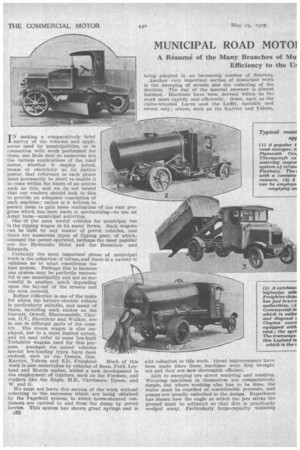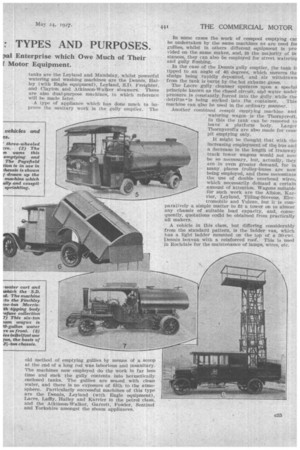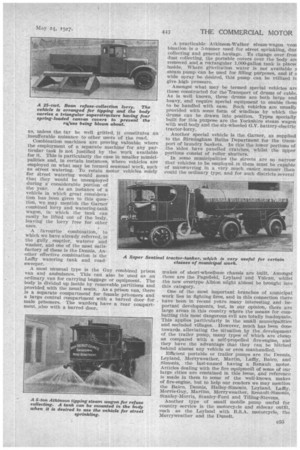MUNICIPAL ROAD MOTO] TYPES AND PURPOSES.
Page 90

Page 91

Page 92

Page 93

If you've noticed an error in this article please click here to report it so we can fix it.
IN making a comparatively brief survey of tile vehicles and appliances used -by municipalities, or in connection with -work performed for them, one finds that so numerous are the various applications of the, road motor, whether it employ petrol, steam or electricity as its motive power, that reference to each phase must necessarily be short to enable it to come within the limits of an article such as this, and we do not intend that our readers should look to this to provide an adequate conception of each machine; rather is it written to permit them to gain some realization of the vast progress which has been made in mechanizing—to use an Army term—municipal activities.
One Of the most useful vehicles for municipal use is the tipping wagon in its many forms. Such wagons can be built by an maker of petrol vehicles, and there are numerous types of tipping gear, of which, amongst the power-operated, perhaps the most popular are the Hydraulic Hoist and the Bromilow and Edwards.
Certainly the most important phase of municipal work is the collection of refuse, and there is a variety of opinions as to what constitutes the best system. Perhaps this is because one system -may be perfectly successful in one municipality and not so successful in another, :much depending upon the lay-out of the streets and the area covered.
Refuse collection is one of the tasks for which the battery-electric vehicle is particularly suitable, and many of these, including such makes as the Garrett, Orwell, Eiectromobile, Clayton, G.V., Electrical' and Walker, are in use in different parts of the country. The steam wagon is also employed,. but to a more limited extent, and we may refer to some low-built Yorkshire wagons used for this purpose. Amongst . the -'petrol vehicles
special kiwi-loading -types -have been "4evolved, such as the Dennis, Guy,
Karrier, :Vulcan and S.D. Freighter. Much •of this work is also undertaken by vehicles of Bean, Ford, Leyland and Morris makes,. whilst a new development is the enaployment of tractors, such:as the Tordson, and
• trailers, like the Eagle, -H.B., • Carrimore, 'Dyson, and W. and G. .
We must notleave this section of the work vvithout referring to -the successes which are being obtained by the Pagetield system, in which horse-shunted containers are carried to and from the dump by petrol lorries. This system has shown great savings and is c32 being adopted in an increasing number of districts.
Another very iraportant section of Municipal work is the sweeping of streets and the collecting of the detritus. The day of the manual sweeper is almost finished. Machines have been devised which do the RI)* more rapidly and efficiently... Some, such as the three-wheeled Lacre and the Laffiy, sprinkle and sweep only ; others, such as the Karrier and Vulcan, add collection to this work. Great improvements have been made since these machines were first brought out and they are now thoroughly efficient.
Akin .to sweeping are street watering and washing. Watering machines in themselves are comparatively simple, but Where washing also has to be done, the water must be expelled at. considerable pressure, and pumps are usually embodied in the design. Experience has shown how. the angle at which the jets strike the ground must be adjusted so that dirt. is practically wedged away. Particularly large-capacity Watering
tanks are the Leyland and Maudslay, whilst powerful watering and washing machines are the Dennis, Halley (with Eagle equipment), Leyland, S.D. Freighter, and Clayton and Atkinson-Walker steamers. There are also dual-purpose machines, to which referenee will be made later.
.A type of appliance which has done much to improve the sanitary work is the gully emptier. The old method of emptying gullies by means of _a scoop at the end of a long rod was laborious and insanitary. The machines now employed do the work in far less time and suck the gully contents into hermetically enclosed tanks. The gullies are sealed with clean water, and there is no exposure of filth to ,the atmosphere. Particularly successful machines of this type are the Dennis, Leyland (with Eagle equipment), Litc.re, Latily, Halley and Karrier in the petrol class, and the Atkinson-Walker, Garrett, Fowler, Sentinel and Yorksbke amongst the steam appliances. In some cases the work of cesspool emptying cat be undertaken by the same machines as are used foi gullies, whilst in others different equipment is pro vided on the same makes, and, in the majority of ir stances, they can also 5e employed for street Watering and gully flushing. , In the case of the Dennis gully emptier, the tank is tipped to an angle of 40 degrees, which ensures the sludge being rapidly deposited, and air withdrawn from the tank is burnt by the hot exhaust gases.
The Lacregullycleanser operates upon a special principle known as the closed .circuit, • and water under pressure is constantly_ forced into the gully while the . detritus is being sucked into: the container. This machine can also be used in the_ordinary.tuanner.
Another combined cesspit emptying machine and watering wagon is the Thornyeroft. In this the tank can be removed to leave a platform body. Larger Thornycrofts are also made for cesspit emptying only.
It might be thought that with the increasing employment of till bus and a decrease in the length of tramway track tower wagons would not now be so necessary, but, actually, they are in even greater demand, for hi many places trolleyLbuses are now being employed, and these necessitate the use of double overhead wires, which necessarily demand a certain amount of attention. Wagons suitable for such work are the Albion, Karrier, Leyland, Tilling-Stevens, Electromobile and Vulcan, but it is comparatively a simple matter to fit a tower on to almost any chassis of suitable load capacity, and, consequently, quotations could be obtained from practically all makers.
A vehicle in this .class, but differing considerably from the standard pattern, is the ladder van, which has a light ladder mounted on the top of a 30-cwr. Dennis boxvan with a reinforced roof. This is used in Rochdale for the maintenance of lamps, wires, etc. A particularly useful form of appliance for tramway-track repairs is the Mobile welding machine, such as the Tilling-Stevens and the Leyland. In the former, the current for welding can be obtained from the dynamo embodied in the chassis, but, in many cases, welding can easily, be effected by taking the current from the overhead equipment. In the Leyland machine the rear door lifts up and is utilized as a roof to shelter the operations, side screens swinging out to assist in affording this protection.
The ambulance services of a municipality are often of great importance; particularly is this so where areas of congested traffic are to be found, but ambulances are employed apart from dealing with.accident cases, as in connection with infirmaries, poor-law
institutions, etc. The modern ambulances are vastly different from the bare and uncomfortable types employed in former times. They are now equipped with every, modern device to assist in affording comfort to the occupants, whilst facilitating the maintenance of _scrupulous cleanliness. Ambulances are dealt with in this issue in a separate article, and we therefore only mention the names of the leading makes, such as the Austin, Bean, Crossley, Dennis, Fiat, Morris, Star, Talbot, Unic and W. and G. The last-mentioned has been built to meet the requirements of the Metropolitan Asylums Board and is a particularly large model.
Much of the work of a municipality is necessarily concerned with road-building and maintenance, and for it large numbers of motor vehicles and motor appliances are employed. Rollers for modern foundations and surfacings are dealt with elsewhere in this issue, but there are other vehicles, such as the Halley tar tanker in use by thip Glasgow Corporation. This
c34
holds 1,000 gallons in a special tank having three compartments for 500 gallons, 300 gallons and 200 gallons respectively. This tank is lagged with asbestos and covered ,with sheet steel, and the pump at the rear of the vehicle assists in the delivery of the tar and for filling barrels etc. The 6-ton W.G.-type Yorkshire chassis can now be provided with an ingenious steam-jacketed body for the transport of hot asphalt, etc. Several are already in service.
Another vehicle built specially for tar is the 1,000gallon Clayton steam wagon. In this case the tar is sprayed by pressure from a pump, the tar being forced through nozzles on to the road. Spraying can be carried out at a speed of four to five m.p.h., and the tank can be mounted on the body of an ordinary wagon and removed for general haulage. A very complete outfit for tar-spraying and gritting is also used in conjunction with the Fowler steam wagon. Tuke and Bell gritting gear for use after tarring is employed with a number of vehicles, including the Bean. This makes a most useful combination, as, unless the tar be well gritted, it constitutes an insufferable nuisance to other users of the road.
Combination machines are proving valuable where the employment of a separate machine for any particular task is not justified by the werk available for it. This is particularly the case in smaller municipalities and, in certain instances, where vehicles are employed on what may be termed seasonal work, such as street watering. To retain motor vehicles solely for street watering would mean that they would be unemployed
during a considerable portion of the year. As an instance of a vehicle in which great consideration has been given to this ques-. ton, we may mention the Garner combined lorry and watering-tank wagon, in: which the tank can easily he lifted out of the body, leaving the lorryfree for other uses. •
• A favourite combination, to which we have already referred, is . the gully emptier, waterer and washer, and one of the most satisfactory of these is the Dennis. Another effective combination is the Lally watering tank and roadsweeper.
A most unusual type is the Guy combined prison van and ambulance. This can also be used as an ordinary van for carrying baggage or equipment. The body is divided up inside by removable partitions and provided with the usual seats. As a prison van, there
is a separate compartment for female prisoners and a large central compartment with a barred door for male prisoners. The warders have a rear compartment, Also with a barred door. A practicable Atkinson-Walker steam-wagon Acorn bination is a 5-tOnner used for street sprinkling, this collecting and geoeral haulage. To change over fron dust collecting, tile portable covers over the body an removed and .a rtctangular 1,000-gallon tank is place( inside. Where g avitation water is not available a steam pump can e used for filling purposes, and if a wide spray• be d sired, this pump can be utilized tc give high pressure.
Amongst what may be termed special vehicles are those constructed for the-Transport of drums of cable. As is well known, these drums are both large and heavy, and require special equipment to enable them to be handled with ease. Such vehicles are usually provided with some form of windlass by which the drums can be drawn into position. Types specially built for this purpose are the Yorkshire steam wagon with well body and the six-wheeled G.V. battery-electric tractor-lorry.
Another special vehicle is the. Garner, as supplied to the Birmingham Baths Department for the transport of laundry baskets. In this the lower portions of the Sides have panelled cratehes, whilst the upper portions consist of roller shutters.
In some municipalities the streets are so narrow that vehicles to be employed in them must be capable of manceuvring in a very much easier manner than could the ordinary type, and for such districts several
wakes of short-wheelbase chassis are hunt. -Amongst these are the 'Pagefield, Leyland and 'Vulcan, whilst the new overtype Albion might almost be brought into
this category. . . . . . .
One of the most important branches of municipal work lies in fighting fires, and in this connection there have been in recent years many interesting and important developments, but; in our opinion,, there are large -areas in this country where the means for combatting this most dangerous evil are totally inadequate. This -applies particularly in the small municipalities and secluded villages. However, much has been done towards. alleviating the situation by the .development of the trailer pump, many types of which are cheap as compared with a self-propelled fire-engine, and they have the advantage that they can be hitched behind almost any vehicle or even manhandled.
Efficient portable or trailer pumps are the Dennis, Leyland, Merryweather, Martin, Laffiy, Baico, and Simonis, the last-named having a Renault motor. Articles dealing with the fire equipmerit of some of our large .cities are contained in this issue, and reference is made in them to some of the well-known makes of fire-engine, but to help our readers we may mention the 13alco, Dennis, Halley-Simonis, Leyland, Laffiy, Morris-Guy, Martins, Merryweather, Renault-Simonis, Stanley-Morris, Stanley-Ford and Tilling-Stevens.
Another type of small mobile pump useful for country service is the motorcycle and sidecar outfit, such as the Leyland with B.S.A. motorcycle, • the Merryweather and the Dunelt.




















































































































































































